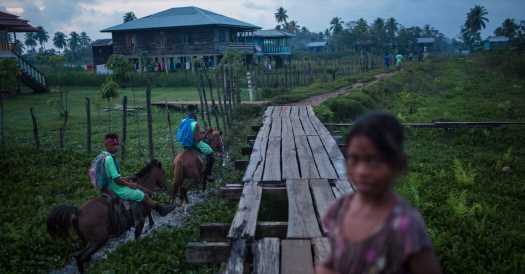Protecting Marine Life Also Benefits the People Nearby, Study Finds

Protecting coastal areas of the ocean from fishing, mining and other human activity can also help people living nearby, according to a study published on Thursday in the journal Nature Sustainability.
People living close to these areas had better food security and greater household wealth, the study found. The region studied is the Mesoamerican coral reef system, which stretches just off Central America’s eastern coast for about 600 miles from Mexico south to Honduras.
To compare fish populations between protected and unprotected areas, the study’s authors analyzed existing surveys of more than 80 fish species conducted by the regional Healthy Reefs for Healthy People Initiative from 2005 to 2018. They found that fish were 27 percent more abundant in fully protected areas compared with unprotected areas. Fish populations remained stable or increased over time in these protected zones.
“The most important finding for me is that marine-protected areas can achieve these co-benefits” for both humans and fish, said Steven Canty, an environmental scientist with the Smithsonian National Museum of Natural History and one of the study’s authors.
The ecosystem harbors more than 60 species of corals and 500 species of fish. Critically endangered animals like the saltwater crocodile and the loggerhead sea turtle live around the reef. About two million people live on the coast, with local economies closely tied to the reef.
This study focused on Guatemala and Honduras, but worldwide, countries are creating more marine-protected areas. Last year, about 190 countries signed a United Nations agreement to protect 30 percent of the planet’s land and oceans by 2030 in an effort to stem biodiversity loss. The United States did not join, but President Biden separately issued an executive order to protect 30 percent of the country’s land and waters.
Scientists, policymakers, industries and communities have debated for years whether marine-protected areas work as intended to sustain fish populations, and whether these areas help or harm their human neighbors. The new study supports the idea that marine-protected areas, at least those with strict bans on fishing, also benefit local people’s health and wealth, even in a region where people have traditionally depended on fishing for their livelihoods.
“We’re still grappling with some of these fundamental questions — not only in this region, but elsewhere — about what works and what doesn’t in conservation,” said Justin Nowakowski, a conservation biologist at the Smithsonian Environmental Research Center and the study’s lead author.
Like other coral reefs, this ecosystem is threatened by climate change and overfishing. Rising ocean temperatures cause corals to “bleach” and die and make the creatures vulnerable to disease.
The ocean is the hottest it’s ever been at this time of year. While climate change remains a long-term challenge for reefs, tackling fishing can take some pressure off the ecosystem, the authors said.
The oldest marine-protected areas in the Mesoamerican Reef were established in the 1970s and ’80s, and over 40 protected areas now cover half the region’s coastal waters. But not all of the areas strictly ban fishing; some simply put limits on how much boats can catch or prohibit certain kinds of fishing gear.
The researchers dug into socioeconomic data from surveys in Guatemala and Honduras conducted by the United States Agency for International Development. They found that children in communities within six miles, or 10 kilometers, of marine-protected areas were approximately 40 percent less likely to have their growth stunted by malnutrition, compared with children living farther away.
Using a wealth index created by other researchers who have analyzed U.S.A.I.D. surveys, the scientists also found that households near the fully protected areas had 33 percent greater wealth than households at greater distances, although most families in the region are still relatively poor by global standards.
“Statistically, it’s a very strong study,” said Natalie Ban, a professor of marine ethnoecology at the University of Victoria, who was not involved in this research. Not many researchers have studied marine-protected areas’ effects on people at this large scale, she said. What wasn’t clear to Dr. Ban from this paper is why and how protected areas in the Mesoamerican Reef led to health and wealth benefits for local people.
Dr. Nowakowski cautioned that his team’s study gave a “20,000-foot view” of marine protected areas in this reef and that more research in nearby communities was needed to figure out how limiting fishing in certain areas might lead to more resources for local people.
Supporters of marine-protected areas argue that the protected areas’ larger fish populations “spill over” into neighboring areas where fishing is allowed and eventually lead to bigger catches for fishermen, or that greater biodiversity can help communities develop ecotourism industries and alternative sources of income.
Dr. Canty said he and his colleagues found evidence that newer marine-protected areas, created with more input and leadership from local communities, performed better than older areas that were “imposed” by federal governments.
Marine-protected areas with strict bans on fishing are “not a panacea,” Dr. Nowakowski said, but they are one potential tool in a toolbox that includes other conservation strategies like catch limits, fishing seasonally and leaving behind female fish with eggs.
Source: Read Full Article